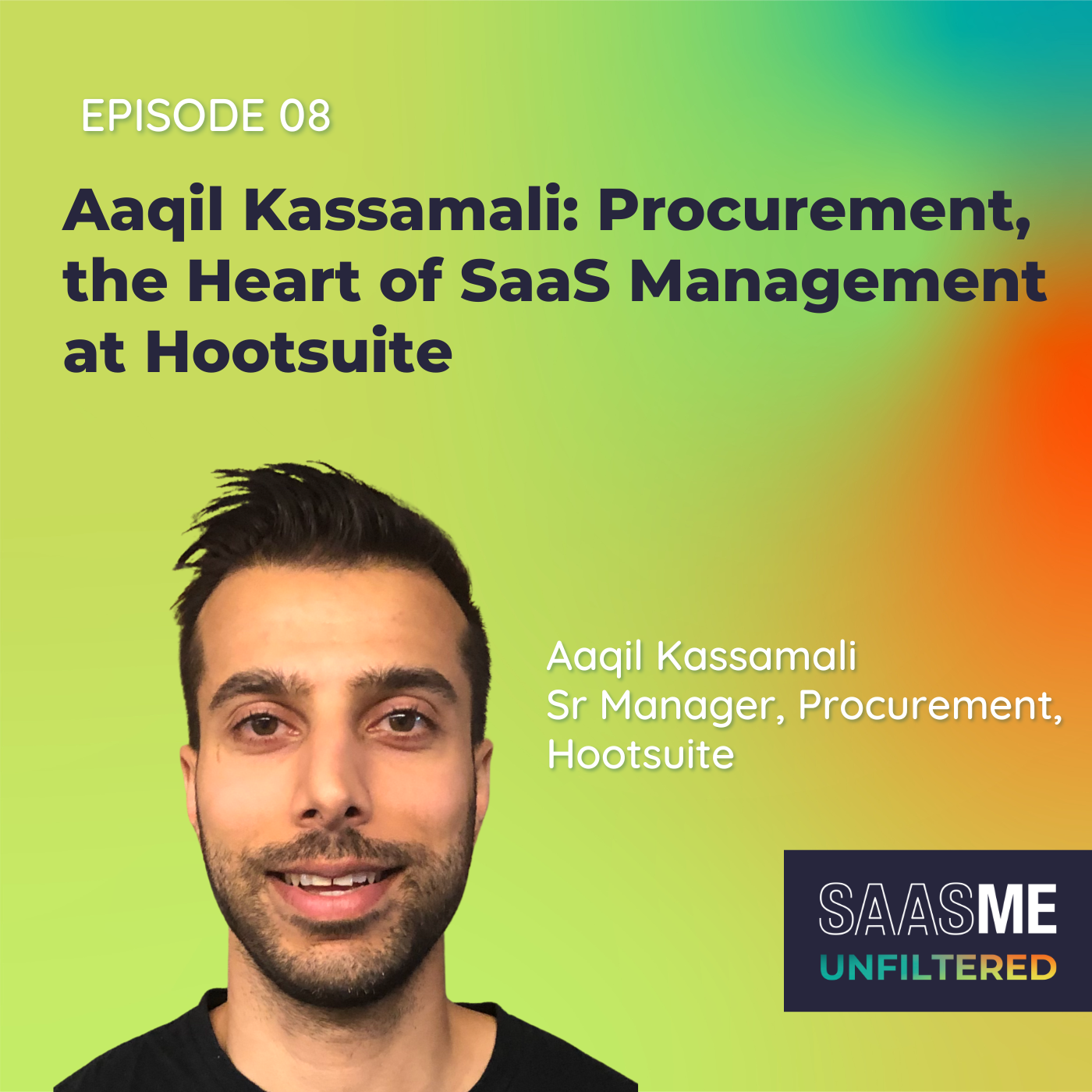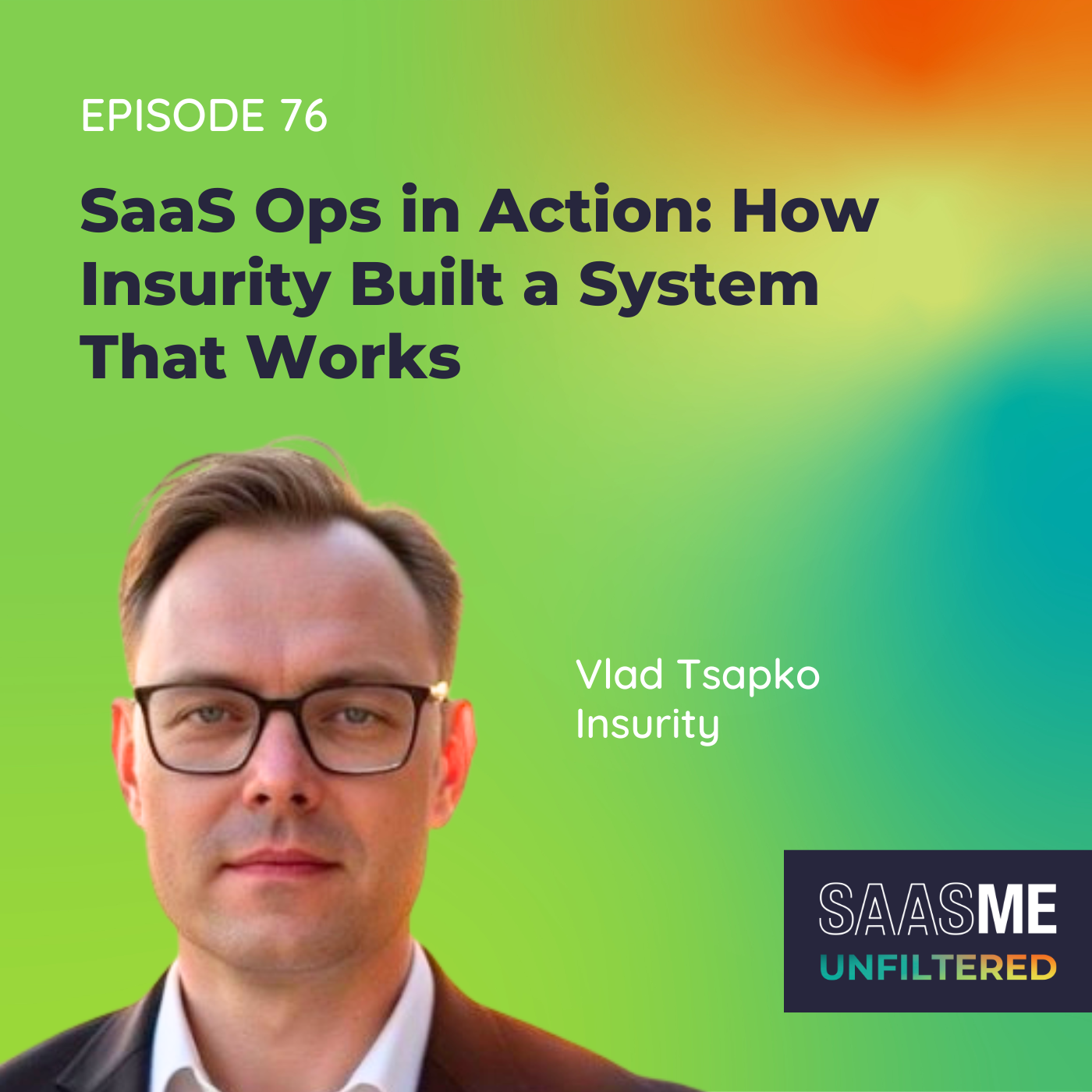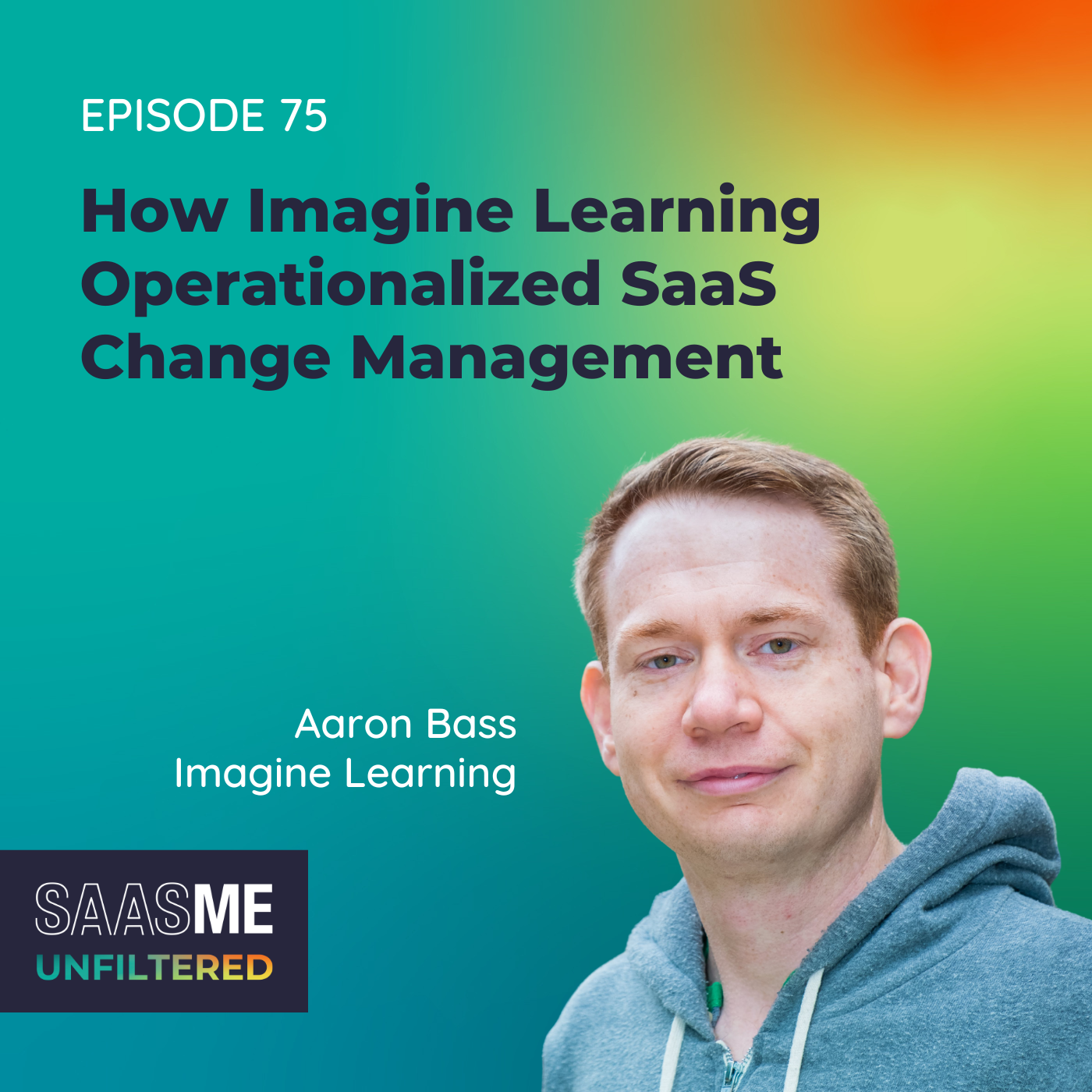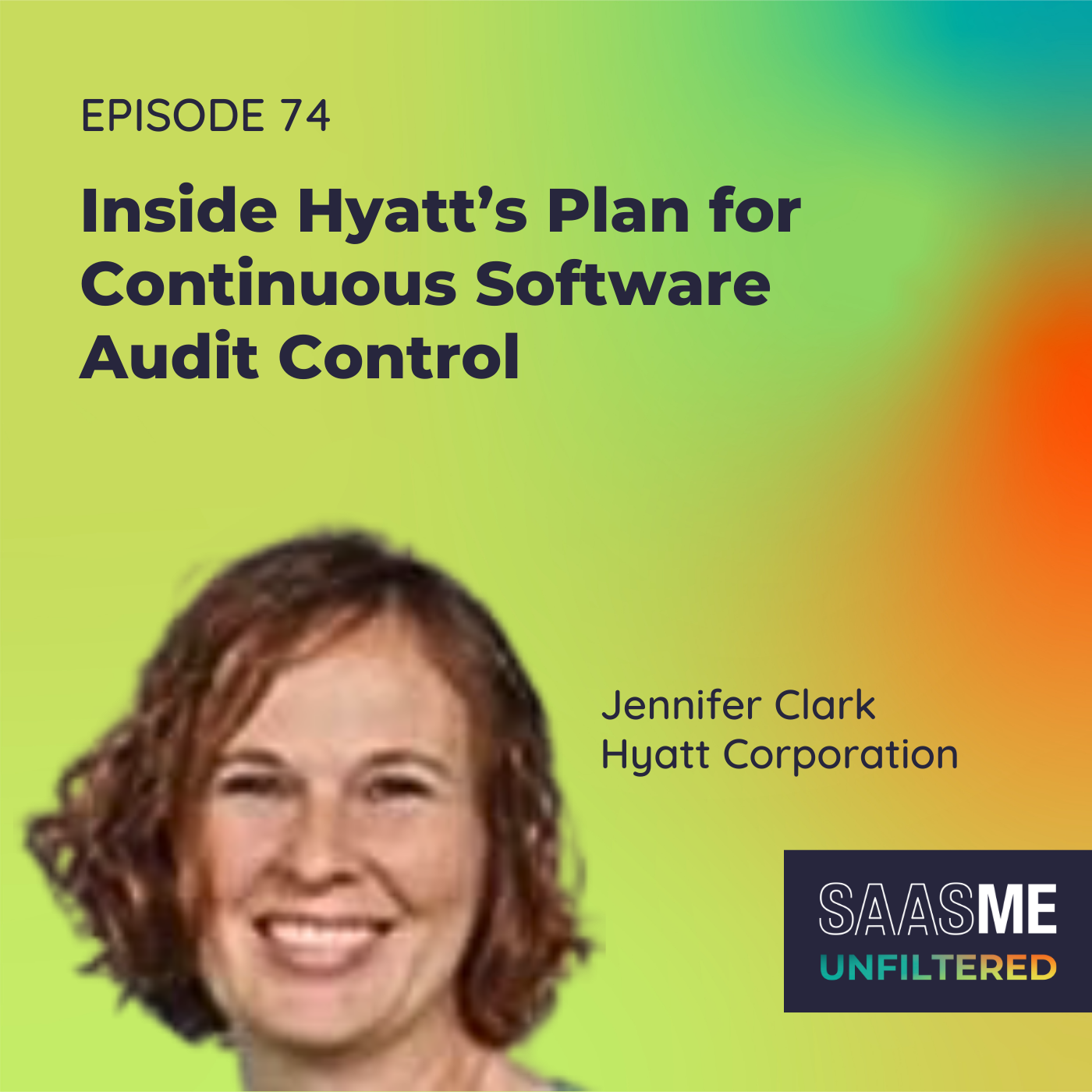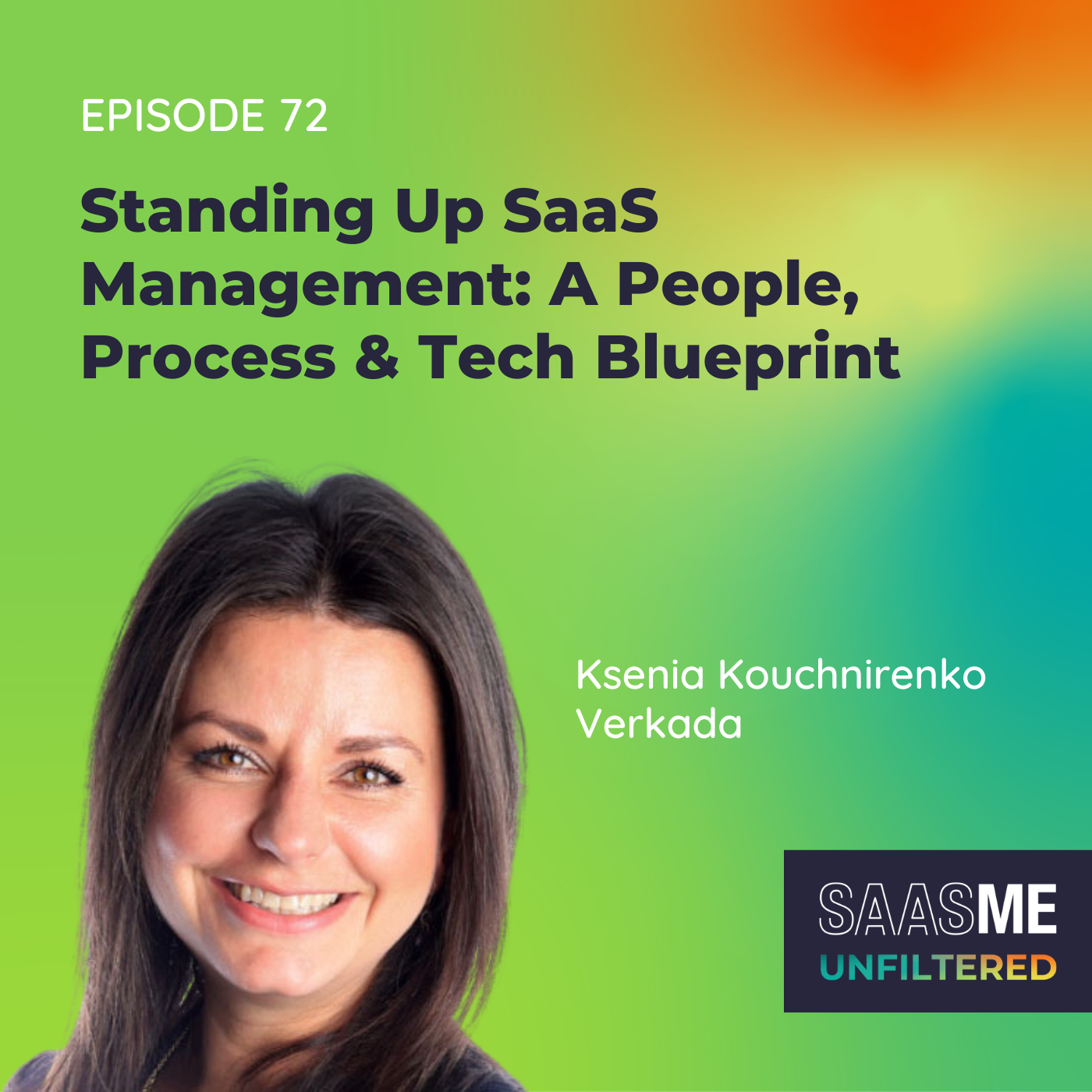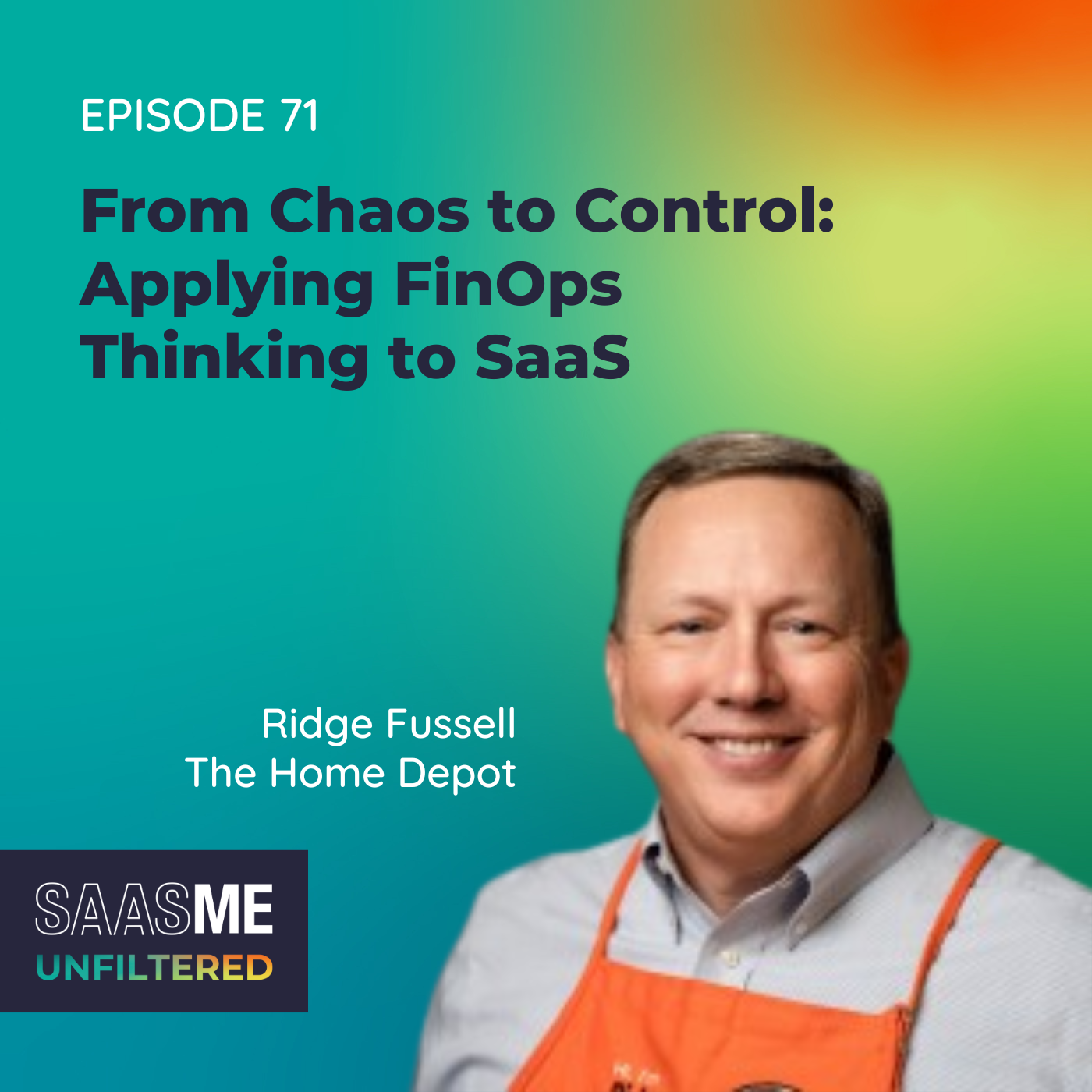Aaqil Kassamali: Procurement, the Heart of SaaS Management at Hootsuite
- 0.5
- 1
- 1.25
- 1.5
- 1.75
- 2
Aaqil Kassamali: If you look at those maps, that it always gets shared of how many vendors and tools are in each category. And now you're looking at a company of, for us, let's just say 1300 people globally, how do we prioritize where we're going to invest? That's always what I dive into. So the process has evolved and it's gotten really good, because it's consolidated, but still within that, who is a decision maker to tell the head of sales that," No, the ROI on this is not quite matching up with what marketing's looking for versus what CTO's looking for, et cetera?" So that high level decision making strategy of where we need to invest, where we need to renew, where we need to add, that I think is the part that's extremely valuable.
Corey Wheeler: Hello, hello, and welcome to SaaSMe Unfiltered, the SaaS management podcast. The show with give it to you straight, real life advice from pros knee deep in SaaS, every single day, SaaS management superheroes, just like you. Really excited to have everyone join us today. I'm Corey Wheeler, co- founder and chief customer officer at Zylo.
Ashley Hickman: And I'm Ashley Hickman, manager of customer success at Zylo.
Corey Wheeler: Well, we are very excited about our guests that we've got on today. This guest really took a non- linear path professionally to become a leader in the SaaS management space. That non- linear path began in sales, where he worked for the Vancouver Canucks, then went into post- grad work in accounting, so that'll be fun to hear about that transition, where he went to work at Hootsuite, where he then transitioned into IT purchasing. And from there, he built the procurement function from the ground up in a fast growing, tech forward organization. He is a native of Canada, he's a Vancouver guy all the way, gigantic sports fan, which I can definitely relate to, fan of the Canucks, the Blue Jays, the Raptors and the 49ers, interestingly enough. I'm very, very excited to welcome Aaqil Kassamali, the senior manager of procurement at Hootsuite. Welcome, Aaqil.
Aaqil Kassamali: Hey, thanks for having me. Really excited to chat with everyone.
Corey Wheeler: We're excited to have you here.
Ashley Hickman: Yeah. So Aaqil, would love to kick off a little bit with some of your background experience. I started out in sales myself, so would love to hear a little bit about your background starting off in sales, your journey into accounting, et cetera. Would love to hear a little bit about those pivotal moments or people that made such an impact on your career that really led to where you're at today.
Aaqil Kassamali: Yeah, I mean, it's interesting, even when I started off in my career, I didn't know anything about procurement, didn't know how to define it. So starting off in sales, I didn't know that was going to be a tool or a skill set that would be helpful in this career. But yeah, I started off in sports, a dream company, dream job for me, working with fans and tickets and selling that way. But after a while, I wanted to do a bit more, get more of a business background. So like Corey mentioned, went back to school for accounting. And instead of going the traditional firm route, there was an opening at Hootsuite. So in Vancouver, the tech scene is pretty robust now, but in the earlier days there was only a few signature companies, Hootsuite being one of them. So I was immediately attracted to the brand and the culture, so decided to start things up there. As I worked through my first year in a bit in accounting, an opportunity came up on the IT side. And this was interesting, because at first you look at it, you're like," Oh, I'm not, I'm not qualified, I don't have the skill set for this." But as you dig a bit deeper, how IT works with finance and the planning plus the buying, it was intriguing. So making that switch was the biggest move I've made so far and to where I've ended up now and working in IT. And as Corey mentioned, the company's moving really fast, that means there's a ton of change and a ton of growth at the same time. And for me, I love it and it's great, because that creates a lot of opportunity. So working in there, learning on the fly, I was pretty grateful for that, coming in green, but being able to learn on the job and then the company maturing. So when I started with the company, there was about 300 people. And when my procurement journey started, it was over 600 people, to give you an idea. And they wanted to centralize procurement, roll out some controls around purchase orders and consolidation of spends, SaaS and non- SaaS. So I found my way through some business operations team and then finally onto legal, which I'm still here now. So it's unorthodox, we're building a procurement function out of legal, but for our company and the skill sets and the people that were around at that time, it made a lot of sense not to get too granular, but building out approvals and signatures and that kind of stuff, that we all know is important.
Corey Wheeler: Yeah. There's a ton of overlap there. I'm definitely interested in talking a little bit more about that, here in a little bit. But as a former procurement leader myself, I'm partial to folks that have built and led procurement teams, so I'm excited about what you're doing, what you've already done and how you're scaling that going forward. But first, did being in sales really give you a little more empathy? Does it give you more empathy in your day to day role? Because you are executing on large scale contract negotiations with your vendors each and every day. Talk maybe just briefly about how being in sales really applies to that overall procurement skillset.
Aaqil Kassamali: Yeah. I mean, I think it doesn't change or my appetite to do what's best for Hootsuite, but it does give me an understanding of what the person on the other side of the table or the other side of the call is experiencing. So for example, if everything is done correctly and the salesperson needs something done quicker for their own numbers, we are happy to do that, to help them. You're not going to just be mean for the sake of it, because I know being on the other end, you need that number.
Corey Wheeler: Yeah.
Aaqil Kassamali: So if everything is aligned, we're okay working faster to build that partnership on that side. But SaaS compared to the kind of sales I was doing, is a different beast.
Corey Wheeler: Oh yeah.
Aaqil Kassamali: The recurring nature, the speed, obviously the size of the deals does have its own quirks and can change a lot of things. But overall, I do understand where these folks are coming from and I think it does help our calls, our first impressions and our ability to close on stuff that we believe is fair for the company.
Corey Wheeler: Yeah, understanding the intent on both sides of the table, what everyone is driving to. I think once you sit in that seat, maybe it's a little bit of empathy, but you really understand that on another level, that maybe just sitting in a procurement role, maybe you wouldn't have that. As we talk to leaders that have emerged in organizations and built from the ground up, there's generally, and we've talked to several guests about this, you've had some sort of, oh, shit moment. So internally at Hootsuite working in accounting, what was that initial, oh, shit moment that Hootsuite had, where procurement needed to be created, there was a challenge or a problem that needed to be solved and you were just the right person to be able to raise your hand and do it.
Aaqil Kassamali: Yeah. And I think that was a new CFO coming in and probably realizing what he had in his previous company and was missing here. In finance, I could see just the speed that the company was growing at, there was probably a ton of redundancy, a ton of, not a lot of budgets, not a lot of rigor around what teams need to be involved in certain types of purchases, but I was never getting deep into that type of stuff. And when I went to IT, I was removed from the finance end, so I couldn't really see what was brewing and being worked on. So when I got that call to make this happen and bring it over, it all clicked, saying," Okay, this makes sense, that we have this going on in a centralized area in IT and all these problems still exist on the finance end. Let's bridge those two things together as we scale." So ideally, this would've started 300 people earlier, but we all know that's not always the case. And you need to get some of the learning out of the way or get the right people in the building.
Corey Wheeler: Yeah.
Aaqil Kassamali: But it all aligned and it made a lot of sense.
Corey Wheeler: Yeah. We see a lot of early stage scaling companies bringing on procurement as a practice and a function with a pro in that seat at 600 employees, is early. Typically, we see it around a thousand employees and maybe a little bit beyond that. So hats off to Hootsuite for really looking at that early on as a core need in the business. So a quick follow up, I'm super excited to learn what you're doing in the future. But as you built the organization, what were some of those big successes and those big challenges that stood out to you as you stood up the function? Those things that were tailwinds that moved you forward and those that were probably a little bit rockier as you implemented those in the business.
Aaqil Kassamali: Yeah. I mean the first big project that I was tasked with, was building out purchase order function. So it sounds, oh, it's just purchase orders, that's not sexy at all. But what it did was, it helped us centralize, if you want to take anything from it, it helped us centralize. So once it gets to the PO stage, everything's done, so that's not where the value is. But what it's doing is, it's getting everybody in the door to get a purchase order. Now, the battle is, at what stage does that purchase come to us? But what it did was, it reduced redundancy, it got us to know who the buyers are around the company and the type of stuff that's being bought and when. It sounds corny, because it's purchase orders, but what it did was, it set the groundwork. And then from there you're like," Oh, who's going to approve this stuff? How quick? How lean should the approvals be? Who's going to sign this stuff?" So all the stuff that you know from being in meeting procurement before, all the stuff starts aligning and you realize you need this stuff. You don't need to reinvent the wheel, but you do need to put these things in place. And then the biggest challenge, and it's still a challenge, is educating, educating our users. It's literally every quarter, we've got a project that's about education.
Corey Wheeler: Yeah.
Aaqil Kassamali: And now we're at over 1300 people, so how do you educate those people? And you just assume people know, but a lot of people don't know, especially in the tech world, maybe it shades a bit younger, in terms of experience and staff, people who haven't been in more built up companies where this is already a practice. So they come from," Hey, I'm a manager. I used to be able to sign a hundred thousand dollar contracts." Or," Hey, I used to be able to go talk to vendors and buy my own software." And now you're educating them saying," No, it's consolidated. I've been doing this for so many years, we're going to partner with you. We're going to get you what you need, but let us do that." So we have really good examples of things that were done amazingly from plan right to pay. And we have stuff that comes in half baked, fully baked with just nothing remaining. And then we're unpacking where we can add value. So I think it's ongoing, but that was the challenge-
Corey Wheeler: Yeah.
Aaqil Kassamali: And still is the challenge. So maybe that's knock on myself that we haven't been better, but I feel like that's just the nature of the biz.
Corey Wheeler: It is, it's all change management, especially building from the ground up. It's never done, you're always advancing your program, but when you roll things out, it is 100% change management. Okay, it's 90% change management, because you've got the platform and the requirements and things like that. But then it's very interesting to hear, what were those challenges? It's just the ongoing education and change management of historical processes. The fear of people that their decision will be taken away from them, when you're really there just to drive strategic outcomes for the company, so I definitely relate to that.
Aaqil Kassamali: Yeah. It's a branding thing too, for the procurement team. I think a lot of people, especially on the sales side, they're like," Oh no procurement." But then internally that's sometimes the image too," Oh, what is procurement? Oh." And they look at security, privacy, they look at legal, it's all roadblocks and jargon.
Corey Wheeler: Yeah.
Aaqil Kassamali: So how do you show them?" Hey, we've got a little bit of business acumen here. We've done this before, we're not going to block you. But you're part of this company, you're a shareholder, you want us to protect our data, our customers and all this stuff." So you want to say all this without scaring them away saying," Okay, but we're going to do all that behind the scenes and we're going to partner with you. So you're still going to buy, but we're going to get this done the right way." Yeah, the other thing is turnover, right? If you lax on a lot of this stuff, people work for companies now, 1, 2, 3 years, they're gone. So if you at scale, don't do this crucial work that's required on the controls, it's going to be a big problem for the company leading down. So we have to sell this to our internal stakeholders saying," Hey, this is not scary. This is pretty standard." What we do at Hootsuite is we try to make it really friendly. We try to make this Hootsuite style. So even how we communicate, what we write up, how we are flexible with how we go to market, we try to tailor it to our partners, the ROI, how quick this needs to move. We try to be really flexible, because we want people to use our function and not go outside the process.
Ashley Hickman: Yeah, that's really helpful to know. And you've shared a little bit, let some bread crumbs right around how the partnership looks like within the business. You have some centralized purchasing with the procurement function that you stood up. But would love to hear a little bit more around what that ownership looks like within your organization.
Aaqil Kassamali: Yeah. I mean, traditionally SaaS sits with IT and it does here as well. That being said, there's so many components to SaaS management that it just can't be fully run within an IT department. So IT owns the overall strategy, but underneath that strategy, we have requests from all over the company. We're a global company, we've gone through M and E, there's so many different niches and use cases for leveraging SaaS. So we have an exercise where the leaders of the certain pillars will prioritize what new SaaS we want to purchase in a given year, along with what we're going to renew. Now, stats sits there, but procurement will now play a role in the budgeting, head count growth. How do we account for that? How renewals come up? Are there going to be increases in the renewal time? Are there going to be added modules? All the stuff that makes this so exciting and so much work, because there are a lot of moving pieces. So it's definitely a partnership and we all have our role to play.
Corey Wheeler: I couldn't agree with that more. So I want to take a little bit of time and dive into the finance versus legal. You've mentioned it a couple times, procurement usually lives in finance, a lot of times we see it living in IT as well. But at Hootsuite, it sits in the legal team. And I love this for a lot of different reasons, but maybe talk about a little bit of that. What are the differences in ownership within those functions? And how do you view that in legal being a little bit different than coming up in a financially driven function like finance?
Aaqil Kassamali: Yeah, I mean, I think when it first started, it was more out of fit and timing of where I should go. It was just a one person, so it might not have been the long term climate at that time. Reporting into the chief legal officer just made sense, so it was by accident. But as the program grew and we're proving everything out, there was no reason to move it away. And I think that stems from me having a really good relationship with the finance organization, empathizing with them being a former employee, even though all the people had turned over. And being able to speak that language, understand how we work with them, that gave them comfort, that it's okay, that this function sits in legal, because there's a good partnership there and I've continued to do that even with new people. So I think that's set the foundation of how that works. In terms of ownership, there isn't a charter or a document that says," Procurement owns this, IT owns this and finance owns this." And I don't know if that's unique to high flying startups, but there isn't something documented, but there's an understanding. And I think it comes from just building relationships. So I don't know if that's from previous career experience or my time at Hootsuite, but I always valued that saying," Hey, everyone's going to have a say in this and how we're going to get this done." And it's worked out so far. Maybe it'll burn me in the future, not having it outlined on a document, but it works. As long as you're communicating and understanding, it's not going to be just procurement that's going to be able to execute on this vision, you're going to find success.
Corey Wheeler: Yeah. So then sitting in legal, shed some light on what are the KPIs that you're tracking as a procurement function? The largest metrics, the ones that you're reporting up to your boss, the CFO and others, share that with us.
Aaqil Kassamali: The main key one, is savings. Now this can be a blend of negotiated savings, reductions and cost avoidance. So those are main things that procurement teams value and work towards and that's no different for us. And then every quarter from there, we'll have projects that we're going to deliver on that we complete on a quarter basis, that could be an official OKR or just be an internal one, where we hold ourselves accountable and it doesn't bubble up. So there's two different levels, level one, I would say, that everyone has visibility on, but then internally we really try to move the ball and move the big rocks. So we're not just being transactional, we're all diving in on things. So whether it's an education KPI or process improvement, we're keeping things going. So we meet weekly and reporting into the senior director in legal, we meet biweekly on seeing a pulse check of where things are. But that savings goal, if you wanted to key in on that, that's the main one for us, because you can see why it's important, why that would be important to finance. And it also shows when you can achieve those numbers and goals, you can tell a lot of work's been done to get to those points, because it's not always easy to do.
Ashley Hickman: Are you blown away by the amazing work our SaaSMe Unfiltered guests are doing? Now, you can join them at SaaSMe, the industry's only SaaS management event. Hear from the experts, discover trends and learn from the pros knee deep in this shit, every single day. Register today at saasme. com, that's S-A- A- S- M- E. com. So one thing that you've spoken to a little bit, that's a key pillar for your organization is education, in terms of seeing the changes that are important. That change management perspective, it's often the biggest challenge for a lot of organizations and you mentioned you invest a lot of time in education. So just want to hear a little bit more about other areas, when it comes to staff that are really important for you diving in from that procurement perspective.
Aaqil Kassamali: Oh yeah, it's the process. So I touched on it earlier, people get scared like," Oh, how long is this going to take? Why is this going to take so long?" Because sometimes things take time. So unpacking that for our internal customers to show them why. What we've done this year that's been great that we partnered with IT as well, is to build a procurement landing page center. And from there you can look at templates, you can look at guides and you can also make all your requests through there. So that's been a scaling game changer for us, because just to touch a little bit back on the education thing, some of it was just going out one year, out the other, who do we educate? How often? So now as long as they just know before you think about buying anything, go to the center, we've allowed us to scale ourselves UP and not really do these sessions as much anymore, because we don't think they were as effective. But that goes back to our process improvement. So we have a continuous improvement mindset. We have forms and we understand everyone's got forms in there, it's not that big of a deal. But what we do is we tinker with it, so after a while, if we're like," Hey, we're not really leveraging or using some of this information we're asking from our internal customers, let's cut it out of there." And then we'll add more, so we might add an OKR line item. We may tinker with some of the pricing and do a bit of our own AD testing on what type of stuff is coming in and how quickly. And before there used to be a security form and a procurement form, now there's just a procurement form. We collabed with security, we got them into our instance of, Zendesk is what we leveraged for internal comms, so we got them in there. So these types of process improvements are continuously ongoing and in order for us to scale, because I can't keep asking for headcounts, for example. So how do we reduce and how do we use what we have? We have great powerful tools and we've got great people, so we have to keep inventing ideas and tests. And the one thing I keep telling the team is," That it doesn't have to be right. We're going to try this out, if it's poor, we can reverse it. We're allowed to make that mistake. We've put thoughts into why we did this. If we need to roll it back or we need to make some changes, we can do it." So now also another thing is sourcing, we're right now, a bit more ad hoc, A bit more reactive on some of that. Now we're being a bit more on the offense on that, but we're not going to wait till the full sourcing program is ready and then do this magical release and then all the problems will be fixed. We're actually just trying to key in on certain areas, certain thresholds with some of the templates we have and get involved with stakeholders we know that'll work with us. So these are the things that go through our mind in our planning. And then there's lots of granular mini tasks that build into these things.
Ashley Hickman: Yeah, I like hearing that you're not essentially that mindset, especially that startup scale up mindset. You're not afraid to build fast and break things and just continue to iterate and improve until you get that desired result and everything coming along.
Aaqil Kassamali: For sure, nothing would get done I feel if we waited for everything to be perfect. And by the time it gets out there, it'll be too late.
Ashley Hickman: Absolutely. It'll never be perfect, right?
Aaqil Kassamali: Exactly, exactly.
Corey Wheeler: Okay. Let's get into SAAS specific detail. We've been working together for a little while now, your journey at Hootsuite around SaaS management. I'd love to talk on your perspectives around SaaS, as you think of the most important areas, likely as with most of our customers, it's usually the number one expense line item, OPEX expense. It's the number one expense line item overall, in most organizations underneath headcount. So what are the important areas that you think about when you think about a sound SaaS management strategy internally?
Aaqil Kassamali: It's prioritization, I think. If you look at those maps that it always gets shared of how many vendors and tools are in each category. And now you're looking at a company of, for us, let's say 1300 people globally, how do we prioritize where we're going to invest? That's always what I dive into. So the process has evolved and it's gotten really good, because it's consolidated. But still within that, who's a decision maker to tell the head of sales that," No, the ROI on this is not quite matching up with what marketing's looking for versus what CTO's looking for, et cetera?" So that high level decision making strategy of where we need to invest, where we need to renew, where we need to add, that I think is the part that's extremely valuable. Then you need to look over and realize that sales, marketing, CTO, legal, they're all going to have their ask, they're all going to think their asks are number one for X reason.
Corey Wheeler: Yeah.
Aaqil Kassamali: You can't buy them all, you can't implement them all even if you can buy them all and you can't integrate them all.
Corey Wheeler: That's right.
Aaqil Kassamali: And then renew them all. So that there's all of this to consider and I think that's why Zylo is such a great space, because we're just learning all this stuff and we're scratching it and there's going to be insights and things that come out of all your years that where you'll go in a different direction and change. Because this space is really, really interesting, because of the recurring nature. And looking at the budget and seeing," Okay, this is our budget now, but we have some multi- year deals, so it's already set for the next year and the year after. So there's only a little bit of wiggle room here." So there's so many avenues.
Corey Wheeler: Yeah, this is where I get on my procurement soap box a little bit, but the rise of SaaS has created a lot obviously. But one of the things it has done, the distributed nature of software throughout an organization, means that there's no real central management, some central strategy with an IT. But whenever there's a distributed area inside an organization that's being purchased, whether it's temp labor services, or it could be travel and expense services, or it could be consulting or heck, it could be the fun office supplies example that everybody always talks about. When that happens procurement really elevates their role within every organization, because everything funnels down into a singular point, which is the point of purchase. And that's where diligence is completed, that's where strategy checks are made. And the rise of SaaS has created such a strategic opportunity for procurement to take advantage of, because there's nobody else in the organization that sees across all expenses and can really help drive that overall strategy. But secondarily the rise of SaaS, I'm a little long in the tooth, so I'll talk about my years, 10, 15 years ago, working in large enterprises, where they had 50 applications across their enterprise. They were all sitting in a room managed by IT. And they were ERP solutions and big, heavy, technically required applications that had to have teams of people managing them. But the advent of SaaS means that now that exact same company has a thousand applications. And with that, comes the operational burden of a thousand renewals and a thousand license write sizes and a thousand true ups and a thousand DPAs and a thousand different onboarding scenarios every year. So the work around SaaS has exploded, but the strategic relevance and importance of procurements role within SaaS is equally as important. So for you to be doing this in a legal organization, collaborating with the business, but being really that central point in the organization with the strategy that IT is leading, is super cool, I would say. And fun to be building on the fly and really highlights that importance of procurements role in managing IT within the organization. No follow up question there needed, but it just sent me on that spiral of, boy, I think the strategic relevance of procurement in SaaS management has never been greater.
Aaqil Kassamali: Yeah. And one thing was also the administration of those tools, those thousand tools. That's now not just IT's, that's split out everywhere, permissions, ad removing, deployment. That is something that's big for us too, on license cleanup and renewal and that stuff. So yeah, you're right, it completely has transformed everything.
Ashley Hickman: So for that, I mean, since we're talking about that, we might as well go into a little bit of that administrative burden piece, right? What some of those challenges are, but what you're doing to mitigate that for yourself, as well as the rest of the business.
Aaqil Kassamali: Yeah. I mean, I think I definitely didn't coin the term, but that renewal fatigue is big, right? Yeah, I mean you could do everything on a one year deal or short term, but is that the best? Is that efficient? Is that cost prohibitive? There's so many reasons why you wouldn't do that if you're being strategic. So you separate your software into different categories. You go to your core and you're strategic and then you have your text group or the ones that you're maybe a bit more flexible on. So I think that renewal fatigue has an immense downstream operations burden, because we go out to this user who has a day job, asking them to submit a renewal and then they're not going to do it, so you're following up with them. And then they're going to eventually submit it, but they've had to do some work to submit and then it comes into our flow and we may review it, it may be very easy, but if not, there might be another security, there might be privacy, there might be legal. So if it's downstream effects and then eventually to the finance world, where the have to process it. So there's lots of things to think about when we make decisions. So a small decision yes or no, can lead to a lot of work.
Corey Wheeler: Yeah.
Aaqil Kassamali: And at scale, whether it's 300 apps or a thousand, it can really, really add up.
Corey Wheeler: Yeah, I like that a lot. You've also hit on the operational burden, but you've also hit on planning and budgeting. And so maybe talk a little bit about procurement's role in that process, but really your thoughts on budget around SaaS in any fast growing organization as well.
Aaqil Kassamali: Yeah, so when we started, it was just normal line item in OPEX budget for each department. They wanted to buy customer success tool, they would go in and buy a customer success tool. Another team may have a similar need and they would go buy a tool and it was dispersed. But now IT was able to consolidate the budget a few years ago and make this all under one budget. And then what we did in procurement, is we closed the loop recently. So them creating the budget, us closing the loop, allowed us to review the savings that were being made, where the overages were, we had some risks. And in there we had line items for new spend, new planned spend, where we would cancel, et cetera-
Corey Wheeler: Yeah.
Aaqil Kassamali: All in one box, which is great. I mean, I see the argument on both ends of how to do this, but this is where we've done it. And I think, because we were so decentralized in the wild, wild west, having this process is a must now. If you ever want to break it out, it's still possible, but this needed to be done to help clean up and create that central entry point. So I think that was really, really key. Now, that's been said there's still many areas of the budgeting process that we want to work on and improve on as this grows, as the money goes big, like you said, a very large line item and when do we start? The other thing we're seeing is teams planning their SaaS budget a year out.
Corey Wheeler: Yeah.
Aaqil Kassamali: It's ideal, but is it realistic. So you're seeing a lot of stuff where people make these plans in October and then come April, March, they're either pivoted completely, not able to make this purchase or those types of things are coming up too. So we're seeing all these patterns and trends.
Corey Wheeler: Yeah.
Aaqil Kassamali: So hopefully, every year we improve on this and then we'll be perfect in 2024.
Corey Wheeler: Perfect, I'm sure. Perfect, everything's perfect.
Ashley Hickman: Yeah.
Corey Wheeler: Right, it's a leading indicator internally in a business for us. It's a leading indicator with our customers right now. We see a lot of the plan is flat, the plan is down X percent or there's a task being handed out in preparation for what many consider to be a little bit of slowdown in the economy. So to do that, you have to have the data, you need to understand the data, you need to understand last year's data, the plan going forward by business unit and then marry that all together and it's a massive effort. I think the opportunity for procurement is only growing, because of the relevance of procurement in this overall process. So I think your takes on budgeting are spot on.
Aaqil Kassamali: Yeah, we're seeing the same thing of where we should be leaning in more and partnering with our friends in IT and finance. So we're already in that mode, so yeah, we're on the same page.
Ashley Hickman: And something would love to... I know for myself as well as for people tuning in, something that everyone's trying to do and you found a better way to accomplish?
Aaqil Kassamali: Better way, I mean, I don't want to say...
Ashley Hickman: Or your best way. Okay, we're working towards perfect.
Aaqil Kassamali: I think it's how you get in contact with us. Sounds small, but we have people speaking different languages, remote workers, small WeWork offices, global nature, M and A. How do you get a hold of us? So it used to be a lot tougher, but with the landing page, which the key point is, it's available through our single sign on through Okta, so everyone has access to it, that's been big. So even if you don't know how to find us, you'll see it in there, or someone can tell you it's there. And once you're there, the world is your oyster. You can read about all of it. Or if you don't want to, you can just get in touch with us through our Slack channel. We have a public Slack channel in there that talks to our three procurement members. You can email us, you can fill out a ticket. So I think how to get in touch with us has been key. We're not just an email address, we actually live in your single sign on. So you can come in and chat, we've put a little bio up, so you can see that we're not just robots and here to make your life miserable. We're here to partner with you, tell internal users a little bit about us. So I think that's been, sounding small, but it was a lot of work to do. It's a lot of effort with multiple teams helping us out.
Corey Wheeler: Yeah. And then for you then, what's next? As we wrap up what you've built, how that's started, the SaaS importance of that category to your business as well. What do you see as the next evolution of procurement at Hootsuite?
Aaqil Kassamali: There's so much. I mean, we've talked about so much there, there's so many categories where we just don't have the time or we haven't invested in where we can affect change and drive efficiencies. So all our learnings on the SaaS side, we can take to, I mean, we're already taking on most categories, but we can do a lot more around events, consultants, contractors, the categories are endless.
Corey Wheeler: Yeah.
Aaqil Kassamali: So I think more of the same, but also getting those people educated into our flow earlier, will be really important. So from a procurement standpoint, that's big. But looking back on it overall, all the operational changes we've made, we could probably do more and lean in on other parts of the business, where we can put our hand up and say," Hey, we've done this over here. Why don't you piggyback on our landing page or on our process and come join and align this, so we can have a lot more visibility throughout the company?"
Corey Wheeler: That's a good focus. Most procurement teams it's remove the tactical, focus on the strategic, but you're always shorthanded. There's always more spend and more categories than you can take on. That means you've got to rely on automation. You've got to rely on tooling to be able to surface those insights and the things that you need to action on. And that's a mantra internally at Zylo, we think about every day, how do we remove the clutter and elevate the strategy to procurement? And as I came into the business, co- founding it, six years ago, it was, this needs to be category strategy, category management strategy in a box. Needs to provide all of the spend, all of utilization, all of the entitlement detail, and then give those recommendations and benchmarks. So that's been our core focus, over the last six years, is how do we become that category management solution? How do we become that it operational platform and really elevate that for the large enterprise going forward? So love your insights there and spot on as you think about what's next for Hootsuite.
Aaqil Kassamali: Yeah. I think the data play is huge.
Corey Wheeler: Yeah.
Aaqil Kassamali: We have a lot, but it's never enough. And how to carve it and where to get it from. So I think that's also another part two that I didn't mention, is that we're really trying to clean up what we have and automate that data, because that's where we're going to get those insights of where we need to lean in. If we just try to go with anecdotes, we may be led in the wrong direction.
Corey Wheeler: Yeah.
Aaqil Kassamali: But if we can get that data of," Hey, actually, if we put some effort into this category, we can really get a lot out of it." But I think it's easier said than done. That's why we leverage tools like Zylo and our ERP system to get these insights.
Ashley Hickman: So one thing, thank you first of all, Aaqil, this has been your insights, your feedback, sharing where you've been and where you're going, has been really, really helpful to hear. So thank you for spending a little bit of time with us today. One thing that we like to close every session out with, is our rack fire. So a little bit of word association here, so you ready to go?
Aaqil Kassamali: Yeah, let's do it.
Ashley Hickman: Okay.
Corey Wheeler: All right. Can be a word, a sentence, whatever comes to mind. Okay, coming up first, procurement.
Aaqil Kassamali: Strategic.
Ashley Hickman: Negotiation.
Aaqil Kassamali: Fun.
Ashley Hickman: Okay, yeah.
Corey Wheeler: Scale.
Aaqil Kassamali: Table stakes.
Corey Wheeler: Yeah.
Ashley Hickman: Nice, nice, nice. That's definitely something like the mantra here at Zylo club. So sports, I know you're a big sports fan, playing or watching?
Aaqil Kassamali: Playing.
Corey Wheeler: Ah, I like that. Well, then I'll go to the other side on the watching and ask you your favorite Joe, Joe Montana, or Joe Carter?
Aaqil Kassamali: It's got to be Montana.
Corey Wheeler: It's got to be. I grew up a Dan Marino fan, Aaqil. So we've got a little bit of a conflict there. But thank you, I really appreciate you coming on today, sharing some of those insights, your founding story of the procurement organization at Hootsuite. I really look forward to what you're up to next, how you're taking SaaS management to the next level and really to watch your organization grow, as Hootsuite overall grows as well. So thanks so much for joining us today, really appreciate it, Aaqil.
Aaqil Kassamali: Yeah, thanks for having me.
Corey Wheeler: Did you enjoy the episode? Pass it along to your friends. Subscribe to get notifications for the latest episode. Share your favorite takeaways and join the conversation on social media using# saasmeunfiltered.
DESCRIPTION
Starting a career in sports sales, Aaqil Kassamali never imagined his journey would take him to building and leading a Procurement team at Hootsuite. From creating broader visibility to turnkey internal processes, it’s become the heart of their SaaS management program. In this episode, discover the lessons Aaqil and his team have learned and his advice for positioning Procurement as a valuable business partner.
Episode Highlights:
- [02:14] Aaqil's background experience in sales
- [04:56] Being in sales and building empathy
- [06:39] The moment Hootsuite realized it needed to cenralize IT and SaaS efforts
- [08:28] Building out purchase orders
- [11:04] The branding of procurement and showing value to hesitant minds
- [12:52] What SAM and SaaS ownership looks like at Hootsuite
- [14:03] Software sits in legal at Hootsuite, how to balance function and needs?
- []15:56 Metrics and KPIs Aaqil reports to his boss
- [18:17] The process and people being fearful for time
- [21:30] Important areas of focus for a sound SaaS management strategy internally
- [23:29] The rise of SaaS and distribution
- [25:47] Tackling the transformation
- [26:13] Discussing renewal fatigue and downstream effects
- [27:33] Aaqil's thoughts on budgeting around SaaS for fast growing organizations
- [31:53 ] The next evolution of procurement at Hootsuite
- [32:52] Data and insights
Today's Host

Ben Pippenger
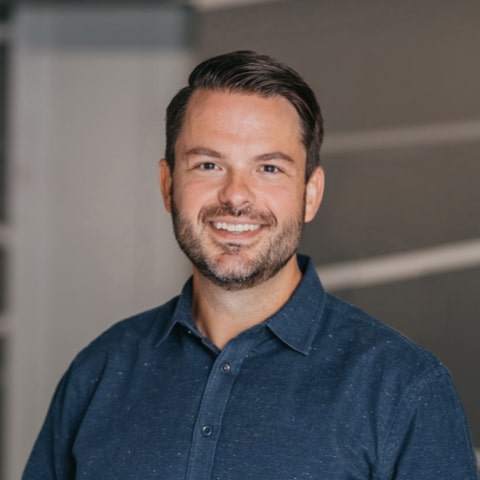
Cory Wheeler

Meredith Albertson
Today's Guests


